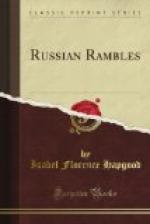The spring was late and cold. I wore my fur-lined cloak (shuba) and wrapped up my ears, by Russian advice as well as by inclination, until late in May. But we were told that the summer heat would catch us suddenly, and that St. Petersburg would become malodorous and unhealthy. It was necessary, owing to circumstances, to find a healthy residence for the summer, which should not be too far removed from the capital. With a few exceptions, all the environs of St. Petersburg are damp. Unless one goes as far as Gatschina, or into the part of Finland adjacent to the city, Tzarskoe Selo presents the only dry locality. In the Finnish summer colonies, one must, perforce, keep house, for lack of hotels. In Tzarskoe, as in Peterhoff, villa life is the only variety recognized by polite society; but there we had—or seemed to have— the choice between that and hotels. We decided in favor of Tzarskoe, as it is called in familiar conversation. As one approaches the imperial village, it rises like a green oasis from the plain. It is hedged in, like a true Russian village, but with trees and bushes well trained instead of with a wattled fence.
During the reign of Alexander II., this inland village was the favorite Court resort; not Peterhoff, on the Gulf of Finland, as at present. It is situated sixteen miles from St. Petersburg, on the line of the first railway built in Russia, which to this day extends only a couple of miles beyond,—for lack of the necessity of farther extension, it is just to add. It stands on land which is not perceptibly higher than St. Petersburg, and it took a great deal of demonstration before an Empress of the last century could be made to believe that it was, in reality, on a level with the top of the lofty Admiralty spire, and that she must continue her tiresome trips to and fro in her coach, in the impossibility of constructing a canal which would enable her to sail in comfort. Tzarskoe Selo, “Imperial Village:” well as the name fits the place, it is thought to have been corrupted from saari, the Finnish word for “farm,” as a farm occupied the site when Peter the Great pitched upon it for one of his numerous summer resorts. He first enlarged the farmhouse, then built one of his simple wooden palaces, and a greenhouse for Katherine I. Eventually he erected a small part of the present Old Palace. It was at the dedication of the church here, celebrated in floods of liquor (after a fashion not unfamiliar in the annals of New England in earlier days), that Peter I. contracted the illness which, aggravated by a similar drinking-bout elsewhere immediately afterward, and a cold caused by a wetting while he was engaged in rescuing some people from drowning, carried him to his grave very promptly. His successors enlarged and beautified the place, which first became famous during the reign of Katherine II. At the present day, its broad macadamized streets are lighted by electricity; its Gostinny Dvor (bazaar) is like that of a provincial city; many of its sidewalks, after the same provincial pattern, have made people prefer the middle of the street for their promenades. Naturally, only the lower classes were expected to walk when the Court resided there.




